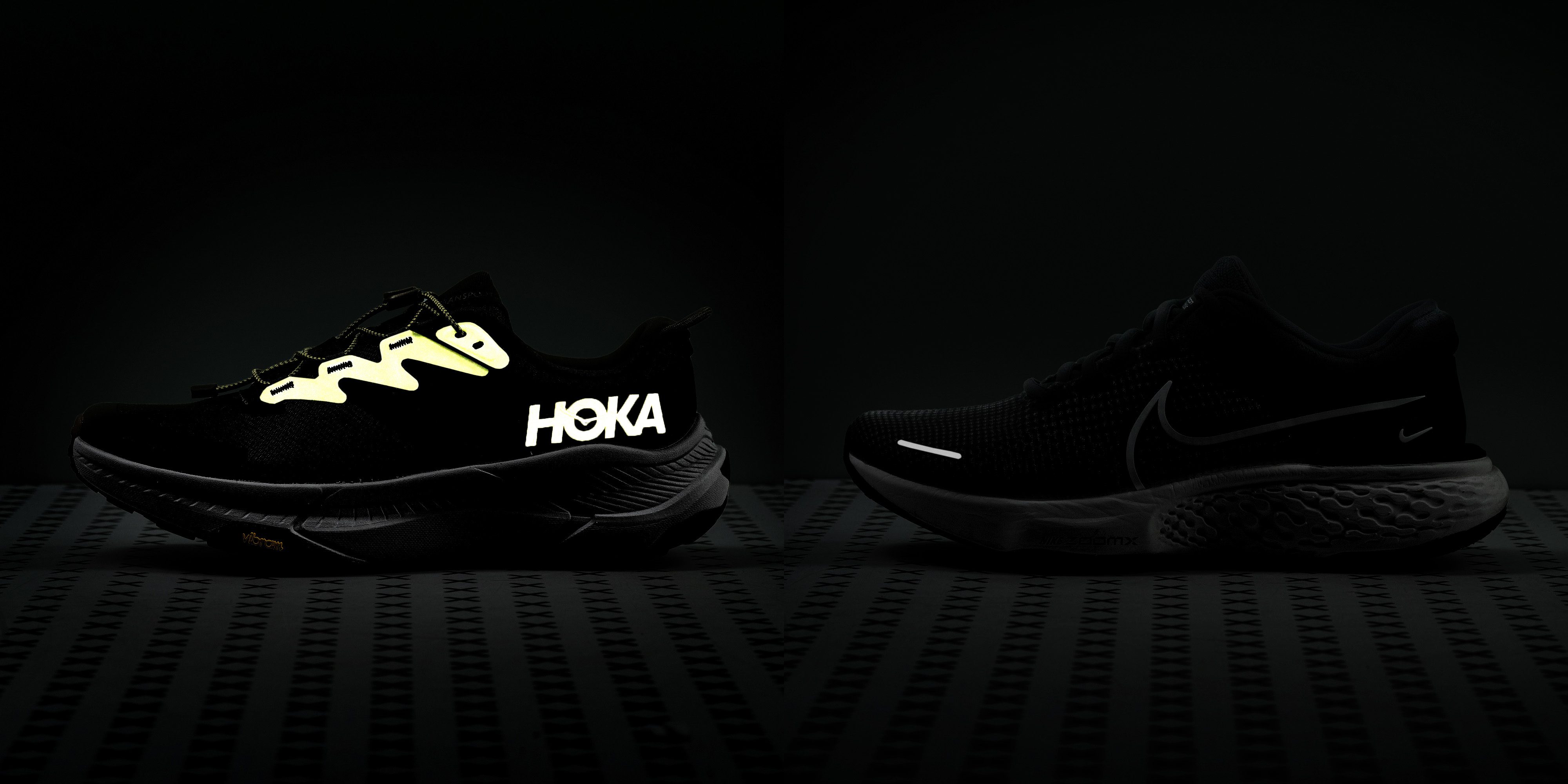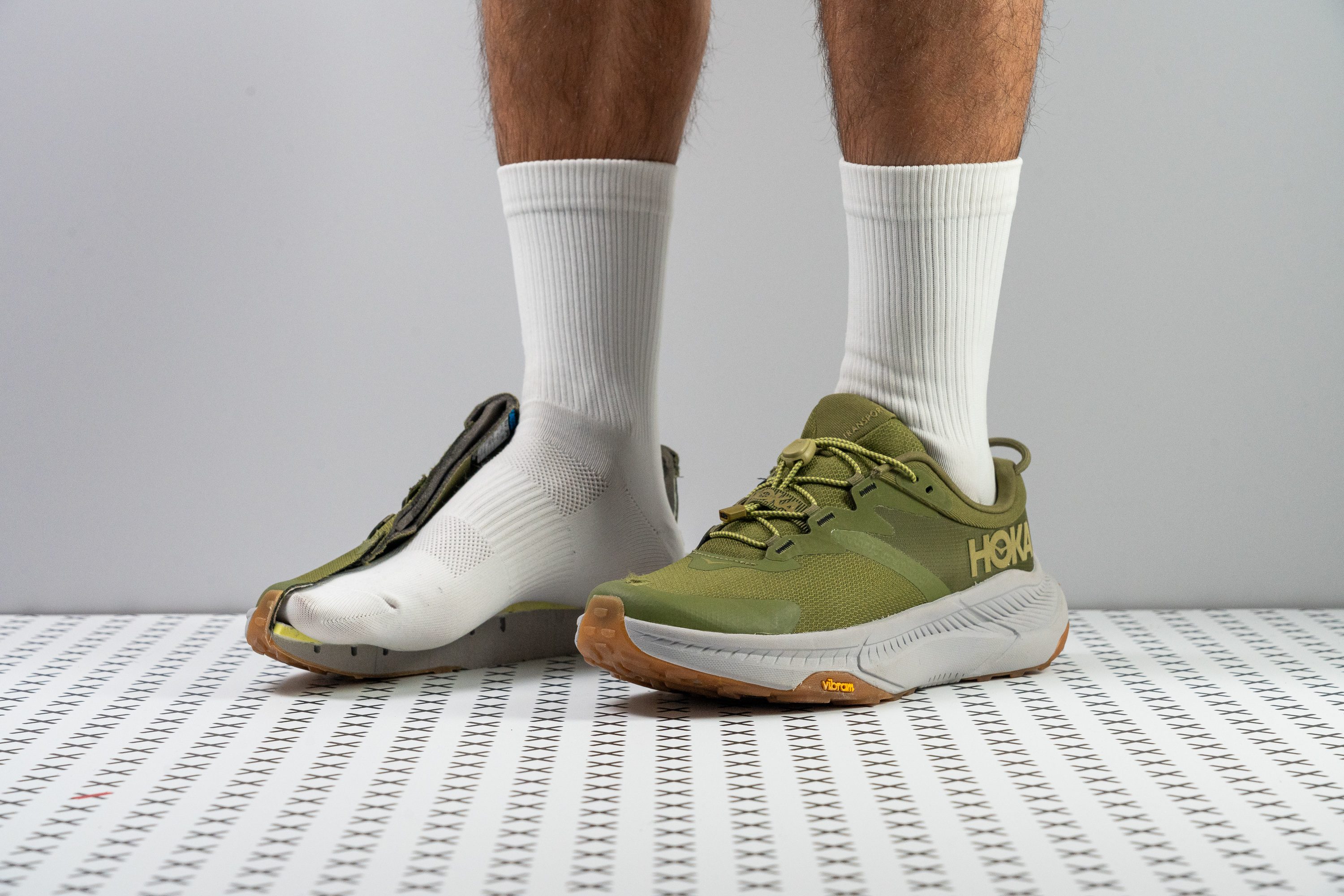Our verdict
- Top pick in best walking shoes
- Top pick in best shoes for walking and standing all day
Pros
- Well-cushioned for all-day wear
- Spacious toe box
- Superior traction
- Reliable outsole durability
- Easy to slip in and out
- True-to-size fit
- Easy to clean
- Sustainable
- Sustainable
Cons
- Not great for warm weather
- Squeaky during break-in
Audience verdict
- Top 17% most popular walking shoes
Comparison
The most similar walking shoes compared
+ + Add a shoe | |||||
|---|---|---|---|---|---|
| Audience score | 82 Decent! | 90 Great! | 92 Superb! | 75 Bad! | |
| Price | £130 | £150 | £100 | £110 | |
| Arch support | Neutral | Neutral | Neutral | Neutral | |
| Shock absorption | Moderate | High | High | Moderate | |
| Energy return | Moderate | High | High | High | |
| Traction | - | High | Moderate | High | |
| Orthotic friendly | ✓ | ✓ | ✓ | ✓ | |
| Weight lab Weight brand | 10.9 oz / 309g 10.9 oz / 309g | 9.4 oz / 266g | 10.8 oz / 306g 10.8 oz / 305g | 11 oz / 313g 11.3 oz / 320g | |
| Lightweight | ✗ | ✓ | ✗ | ✗ | |
| Breathability | Warm | Warm | Moderate | Warm | |
| Use | For standing all dayCityDisneyEurope | For standing all dayTravelCityDisneyEuropeFor nurses | CityDisneyEurope | CityDisneyEuropeRecovery | |
| Size | True to size | True to size | True to size | True to size | |
| Midsole softness | Balanced | Balanced | Soft | Balanced | |
| Difference in midsole softness in cold | Big | Normal | Small | Big | |
| Insole thickness | Average | Very thin | Thin | Very thick | |
| Removable insole | ✓ | ✓ | ✓ | ✓ | |
| Stiffness | Stiff | Moderate | Moderate | Moderate | |
| Torsional rigidity | Stiff | Stiff | Stiff | Moderate | |
| Heel counter stiffness | Moderate | Flexible | Flexible | Flexible | |
| Heel tab | Finger loop | None | None | Extended heel collar | |
| Drop lab | 8.0 mm | 8.7 mm | 9.3 mm | 7.5 mm | |
| Heel stack lab | 34.1 mm | 35.5 mm | 34.9 mm | 32.7 mm | |
| Forefoot | 26.1 mm | 26.8 mm | 25.6 mm | 25.2 mm | |
| Width / fit | Narrow | Medium | Narrow | Narrow | |
| Toebox width | Narrow | Medium | Medium | Medium | |
| Closure | Bungee laces | Bungee laces | Laces | Slip-on | |
| Toebox durability | Good | Good | Good | Good | |
| Heel padding durability | - | Bad | Decent | Decent | |
| Outsole durability | - | Good | Decent | Bad | |
| Midsole width - forefoot | Average | Wide | Average | Average | |
| Midsole width - heel | Average | Wide | Wide | Very wide | |
| Outsole hardness | Average | Average | Very hard | Soft | |
| Outsole thickness | Average | Average | Average | ||
| Tongue padding | Average | Average | Thick | Thin | |
| Tongue: gusset type | None | Both sides (semi) | Bootie | Sock like | |
| Material | - | Mesh | Mesh | - | |
| Ranking | #34 Bottom 5% | #12 Top 34% | #6 Top 17% | #36 Bottom 1% | |
| Popularity | #6 Top 17% | #5 Top 14% | #7 Top 20% | #18 Top 50% |
Cushioning
Shock absorption
Even though it's not as mind-blowingly cushy as some of the other HOKA walking shoes we've tested, the HOKA Transport still showed an above-average shock absorption measurement of 116 SA.
The shoe offers plenty of impact protection to support your long city adventures on hard concrete.
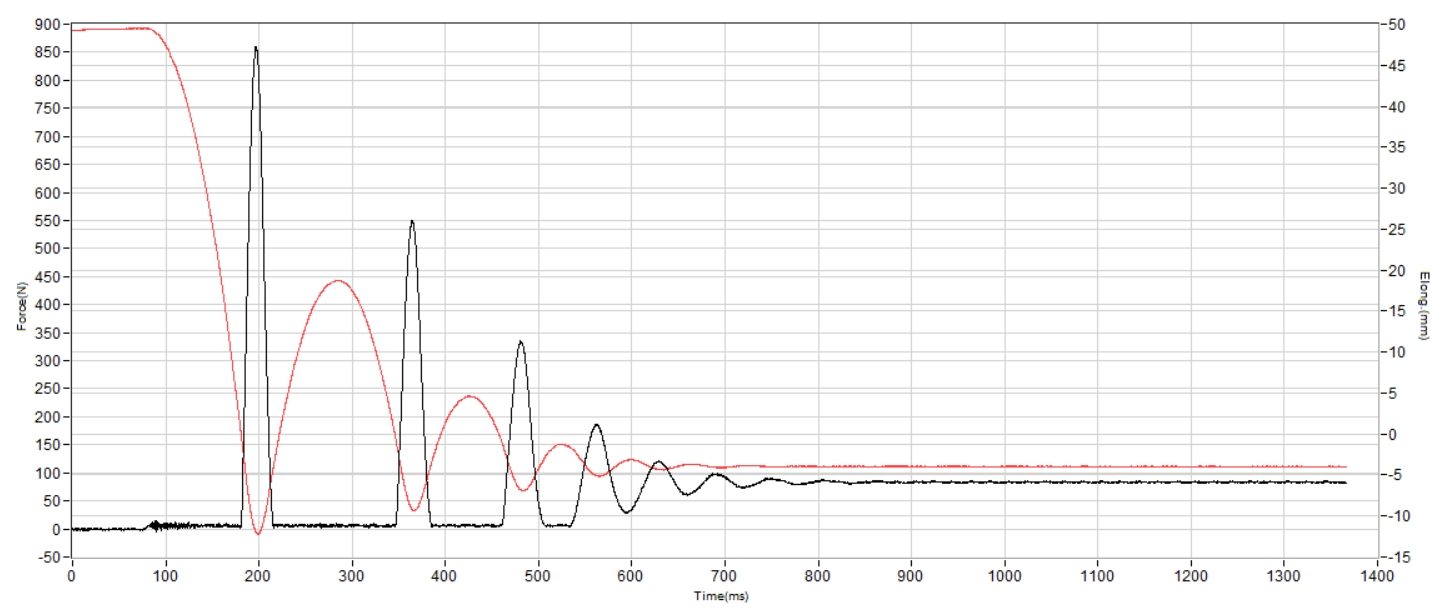
| Transport | 116 SA |
| Average | 111 SA |
Energy return
We couldn't help but notice that the Transport lacks some pop and springiness underfoot.
Even though it doesn't make this HOKA shoe less comfortable, it results in a more static and stable ride. This is reflected in the shoe's low energy return score of only 45.3%.
| Transport | 45.3% |
| Average | 51.1% |
Size and fit
Size
HOKA Transport fits true to size (224 votes).
Flexibility / Stiffness
We couldn't help but notice how it takes effort to flex the shoe in the forefoot.
To assess its flexibility, we measured the amount of force it takes to bend the Transport to a 30-degree angle, and at 18.1N, it required 30% more force indeed!
However, the shoe's stiffness didn't get in the way of smooth transitions. Its platform has a prominent rocker shape which helped our foot roll through each stride effortlessly.
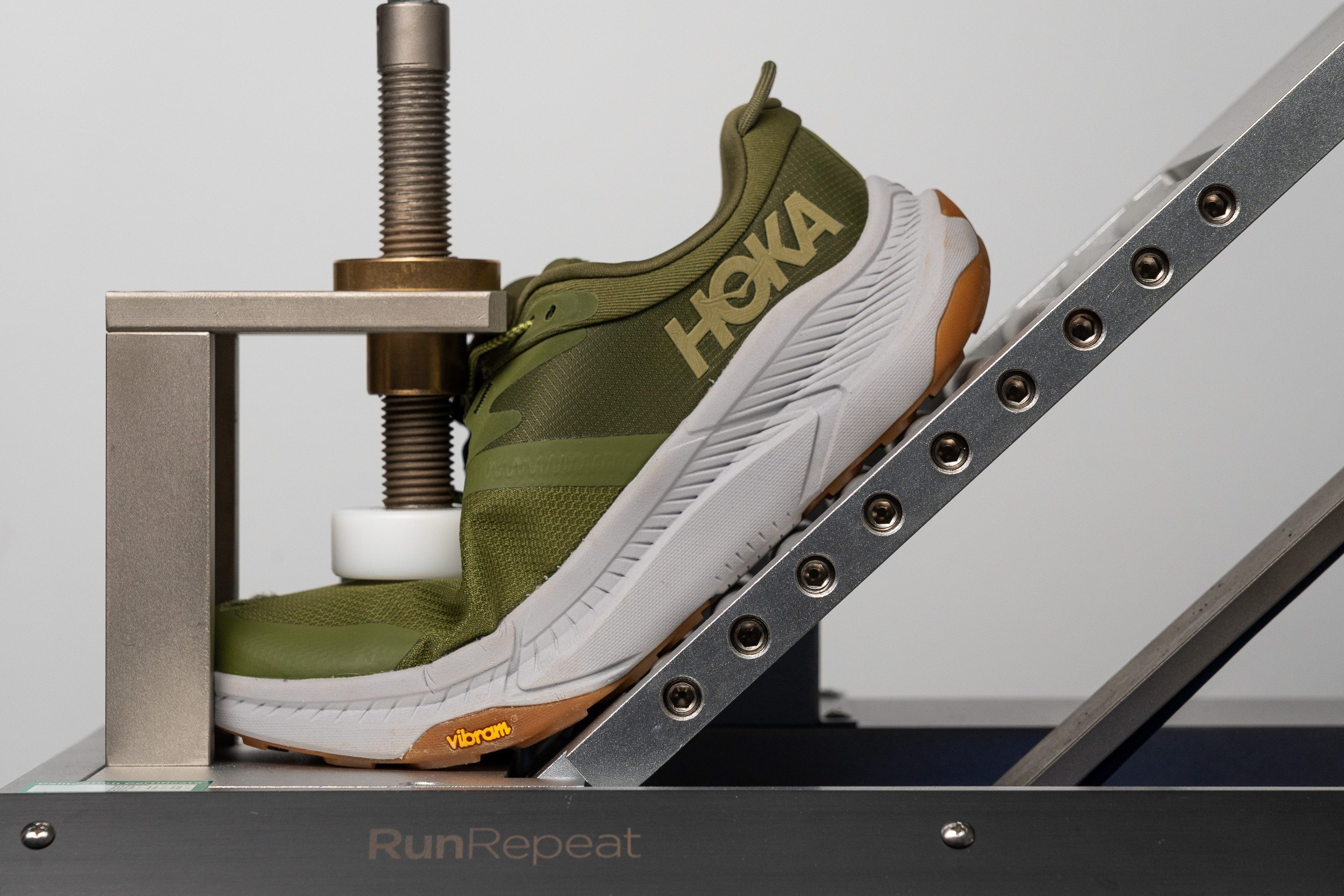
| Transport | 18.1N |
| Average | 13.9N |
Who should buy the Hoka Transport
The Transport is a dedicated walking shoe from Hoka that is a solid pick for:
- Commuters and urban trekkers who are looking for a shoe that not only gives all-day comfort but also keeps them and their feet safe and well-protected day and night.
- Hoka fans who want a pair of kicks that bridges the gap between good looks and their daily trainers.
- Avid walkers who are in the market for walking shoes that are durable enough for miles of walking and are ready to pick up the pace when a stray dog decides to go after them.

Who should NOT buy it
The sturdy upper on the Hoka Transport can make your feet toasty. For a pair of walkers that keep it cool inside, we recommend the Allbirds Tree Runner as equally cosy in warm and cold weather.
Also, the On Cloudaway is a trendy alternative that doesn’t have squeaking issues.
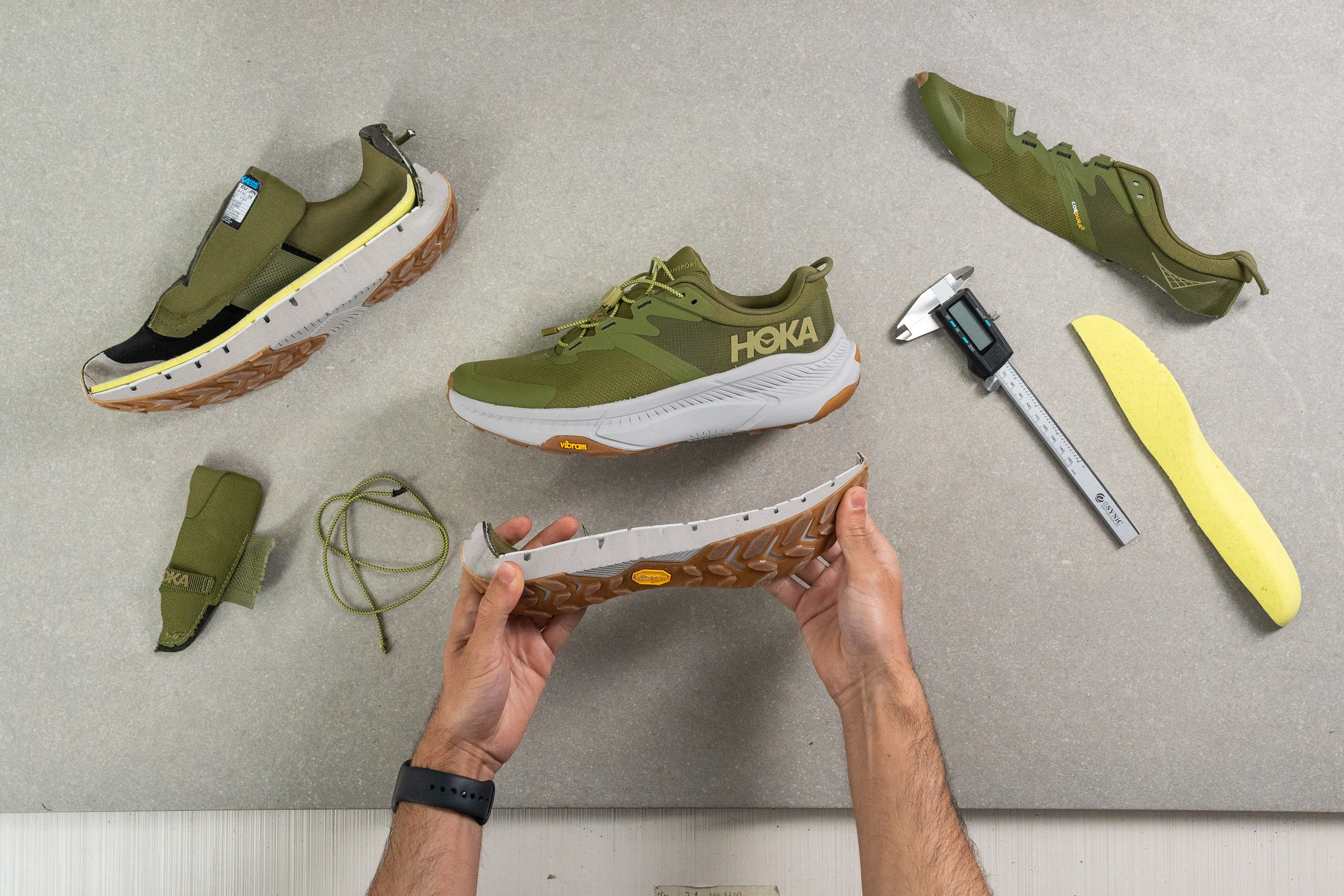
An upper that works but still needs some work
The Cordura upper, made of 100% recycled plastic, has top-notch durability we really admire. We find it very protective and scuff-resistant while using the shoe.
The Hoka Transport is indeed a tank of a shoe! Based on the results of our Dremel durability test, it is comparable to some hiking shoes in their sturdiness. The video below shows how much more durable the Transport's upper is compared to an Adidas running shoe.
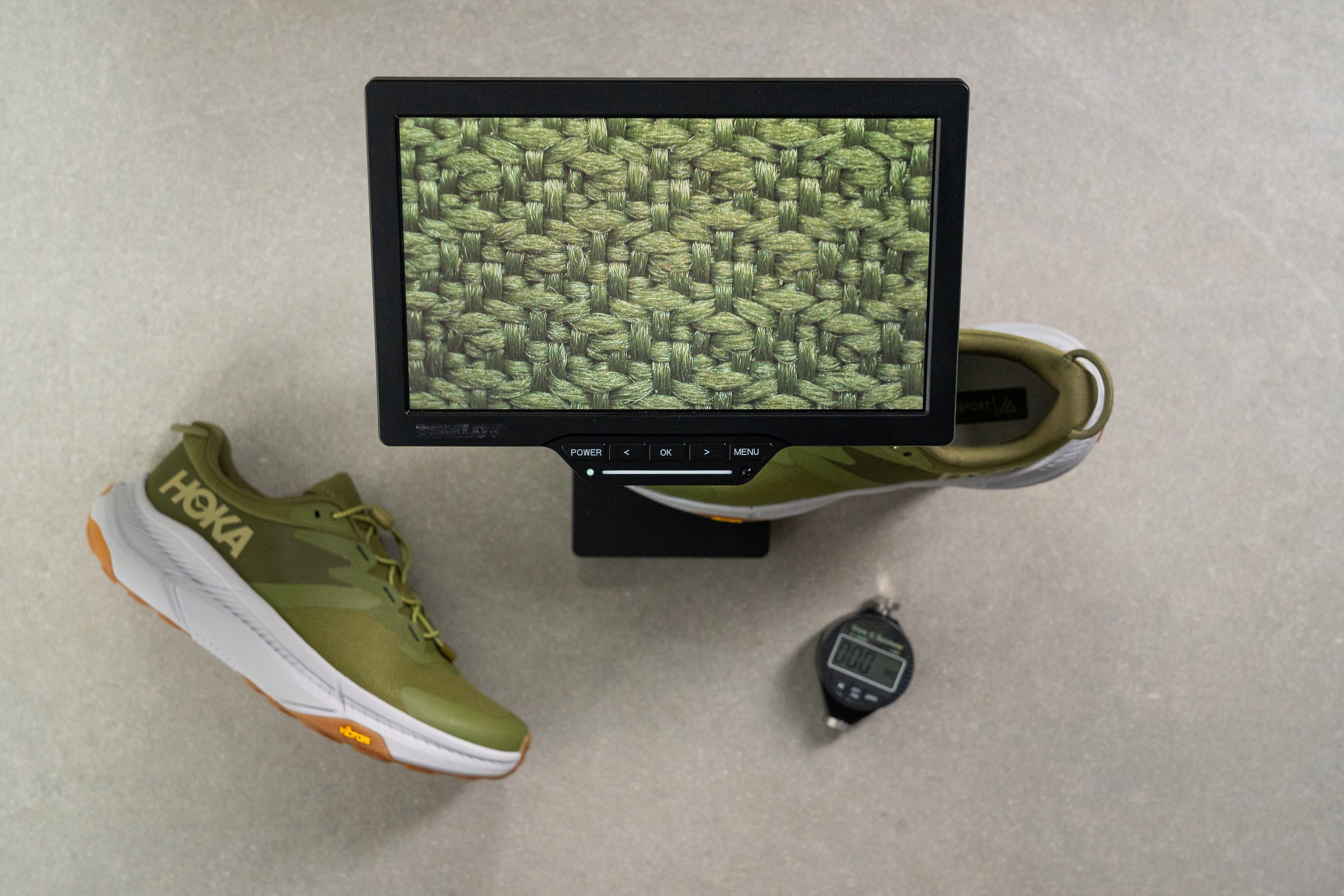
Looking at the shoe's upper fabric through a microscope, it is in fact hard to tell apart from the waterproof textile on the Salomon X Ultra 4 GTX hiker.
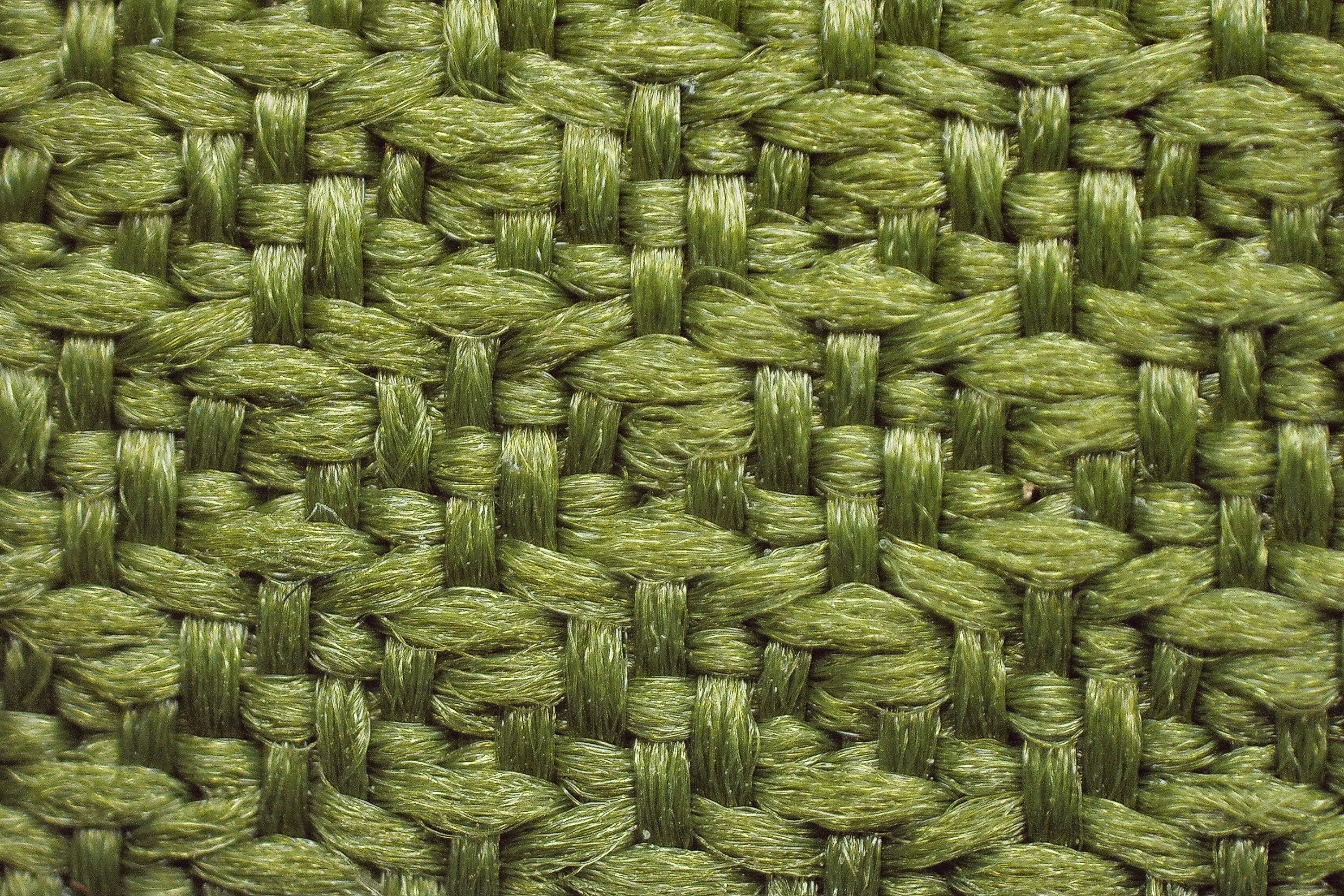
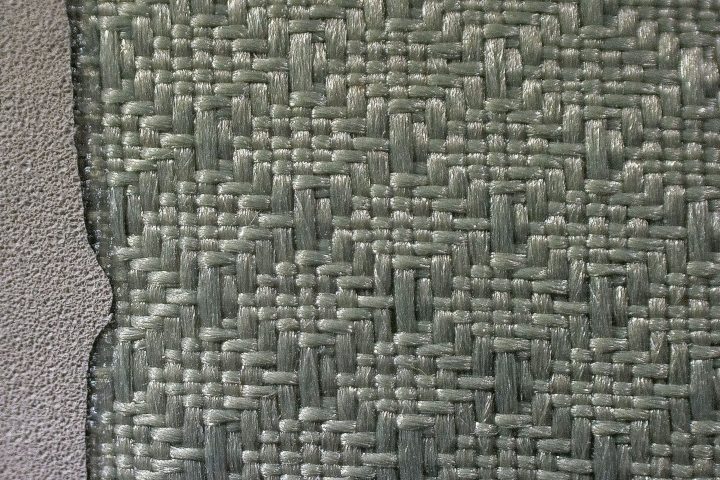
It was easy to maintain the upper material of the Hoka Transport. We loved how it survived plenty of mud on our adventures and was easy to wipe clean afterward.

However, we felt that the upper lacks breathability. Although we loved sporting these kicks in the winter, putting them through the warm weather makes it a less pleasing experience.
This walking shoe from Hoka is among the least breathable ones on our roster. Having pumped smoke through its upper, we found that it barely lets it pass compared to shoes with mesh uppers. We rated the shoe 2 out of 5, where 1 is the least breathable.
You can also observe that the upper doesn't let any light through either in the video below.
The Hoka Transport is a definite ‘yes’ for the daily commute
For a long day of walking, a light jog, and even the occasional sprint to catch the bus, these kicks tick all the boxes. We only find it right to call it city-savvy and commuter-friendly with its sleek and stylish look that looks good and feels good on feet, too.
In times when we had to sprint unexpectedly, we felt like we were wearing running shoes.
Also, adding to the commuter-friendliness of the Hoka Transport, the integrated pull tab and elastic laces make them a lazy person’s dream. This makes sliding in and out of them super easy, which translates to making them really good airport shoes as well.

We discovered that these kicks also come with traditional laces for walkers who prefer lacing up in a more classic manner.

Pure heaven for feet
From the initial step, we immediately felt extremely comfortable in Hoka Transport. These shoes felt great fresh out of the box.
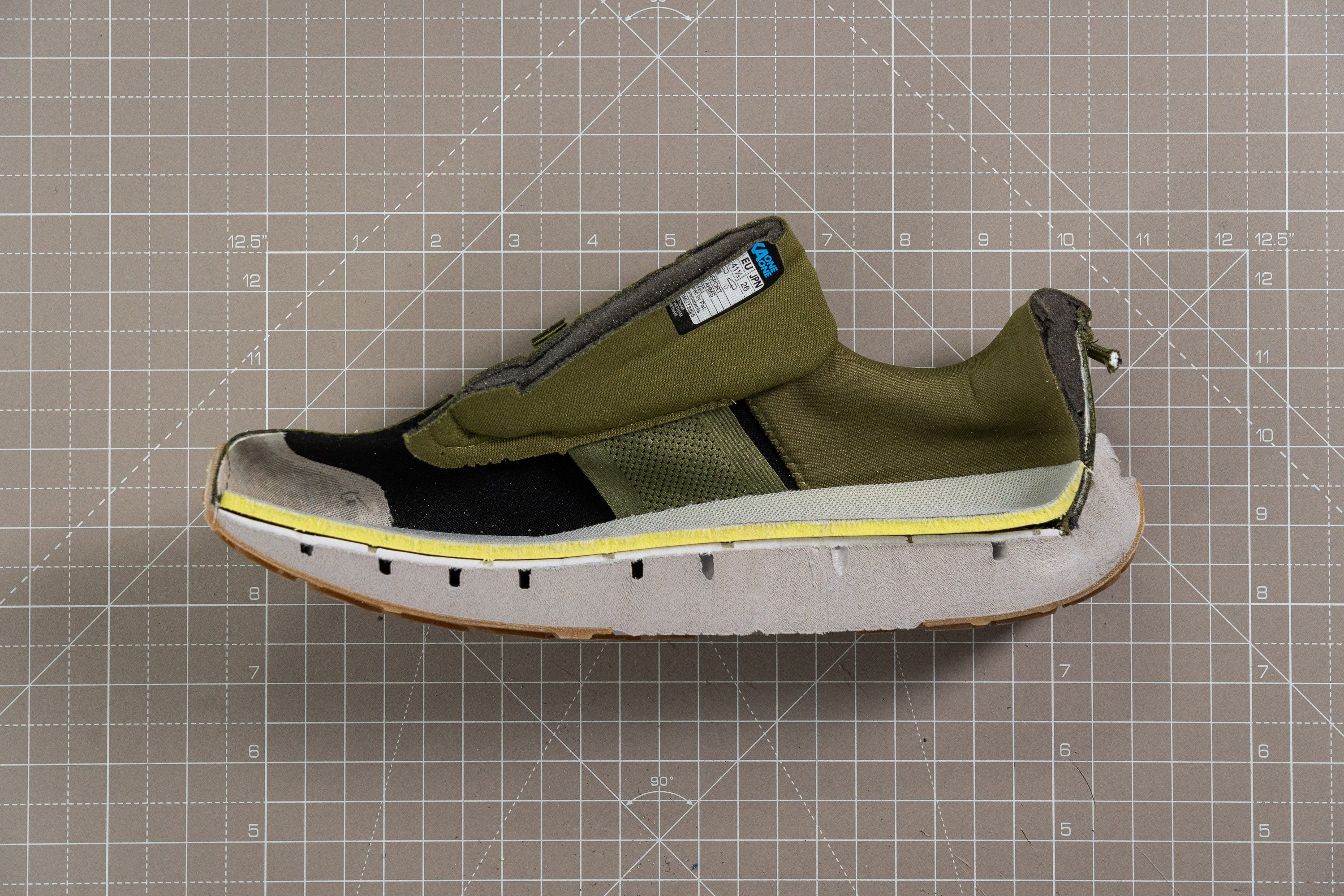
The shoe's well-padded interiors, namely its tongue and collar, are among the first contributors to that pleasant feel.
We measured the tongue of the shoe at 7 mm which is more cushioned than the average 4.1 mm.
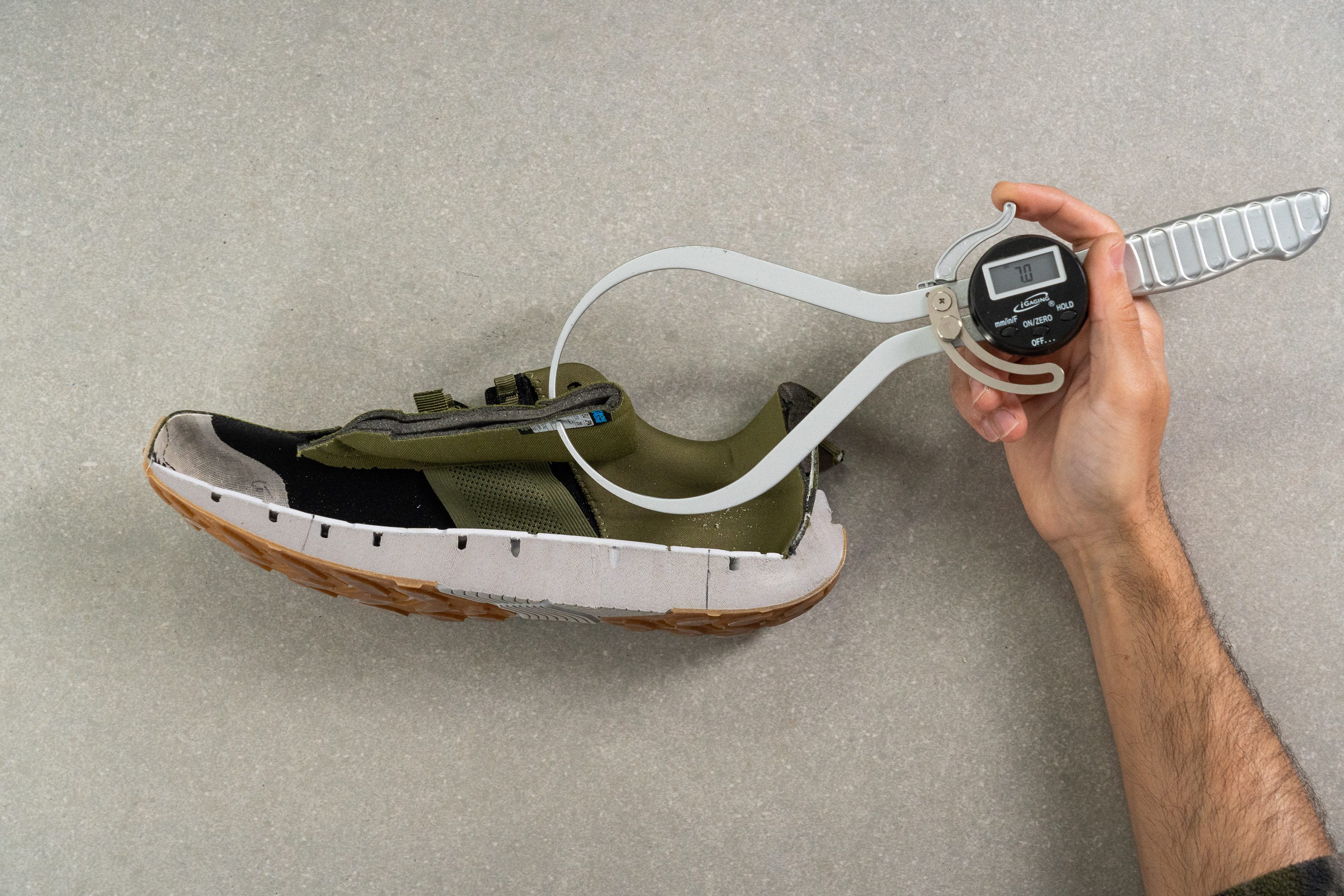
The Hoka Transport has Goldilocks-level cushioning
These daily walkers sport the compression-moulded EVA, which contains 30% sugarcane. We found this to strike a delicate balance between a soft and firm feeling underfoot. This slight firmness allowed us to wear the Hoka Transport all day.
We thought that the cushioning of Transport reached a magical sweet spot between a Clifton and an Arahi.
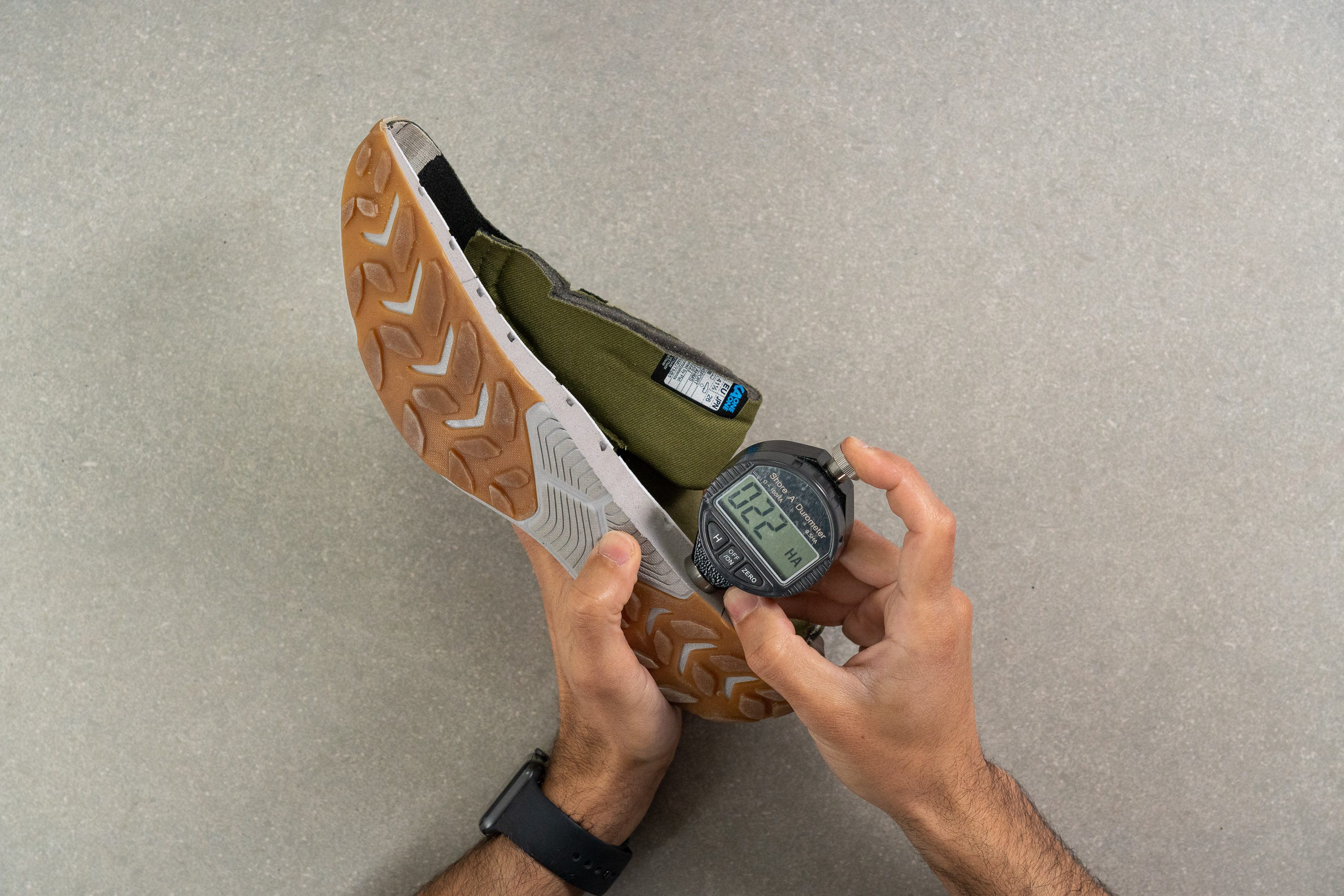
Using a durometer to check how soft the shoe's foam actually is, we found that it is 23% softer than walking shoes in our lab on average.
But when compared to other Hoka shoes we've tested, the Transport belongs to the balanced (neither too soft nor firm) range of cushioning.
| Hoka Clifton 9 | Hoka Transport | Hoka Arahi 6 | |
| Durometer measurement (HA) | 20.4 (plush) | 21.9 (balanced) | 41.0 (firm) |
What's more, the Hoka Transport has a more generous helping of cushioning than most walking shoes. We measured its heel stack at 34.1 mm (3.2 mm thicker than average).
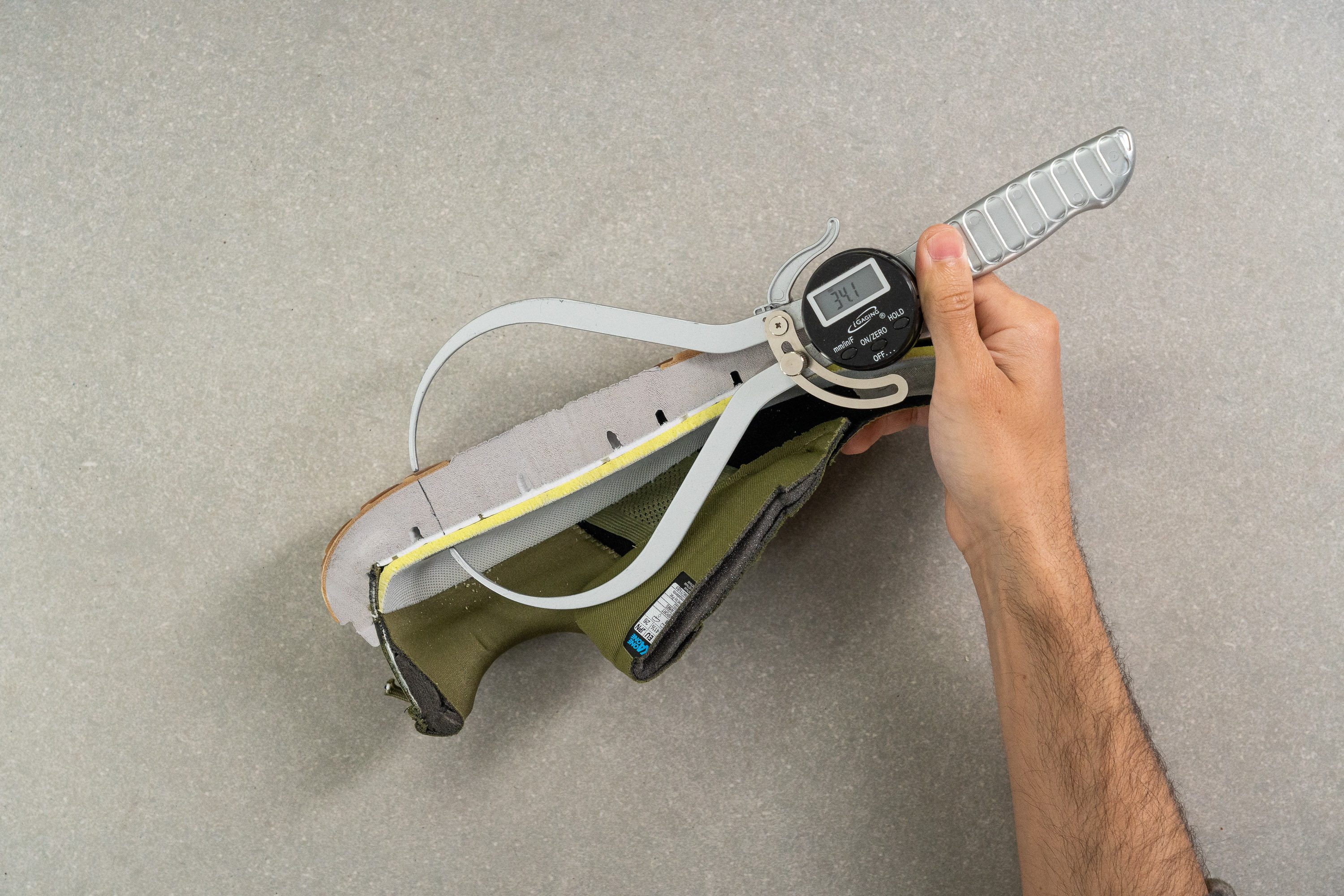
In the forefoot, the shoe's stack height is 26.1 mm (4.7 mm thicker than average).
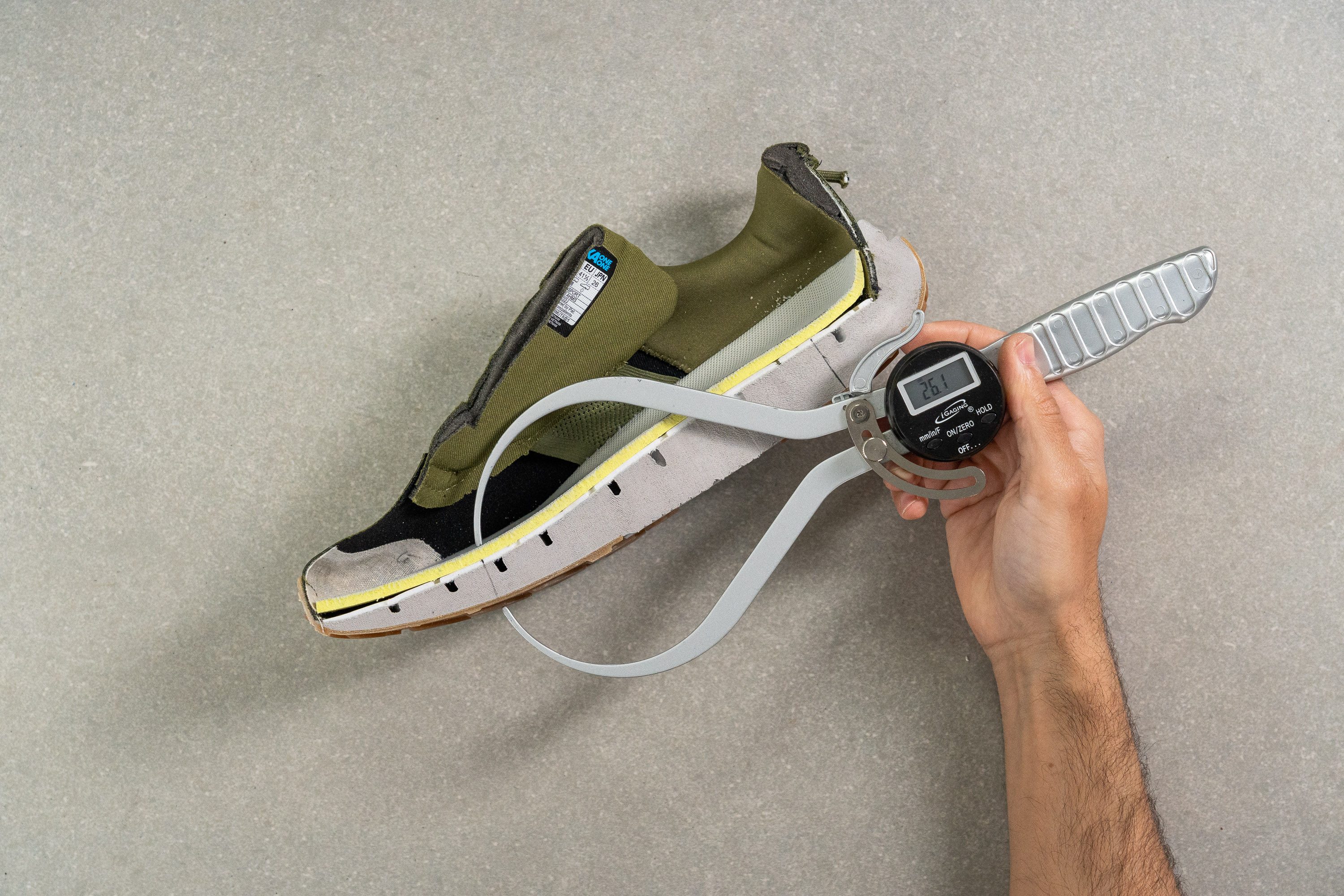
For a Hoka shoe, however, this kind of stack height is considered average.
The difference in height between the heel and the forefoot leaves us an 8-mm drop in the Hoka Transport. This is higher than the stated 5 mm on Hoka's official website. So, you are going to feel like your heel is a little more elevated.
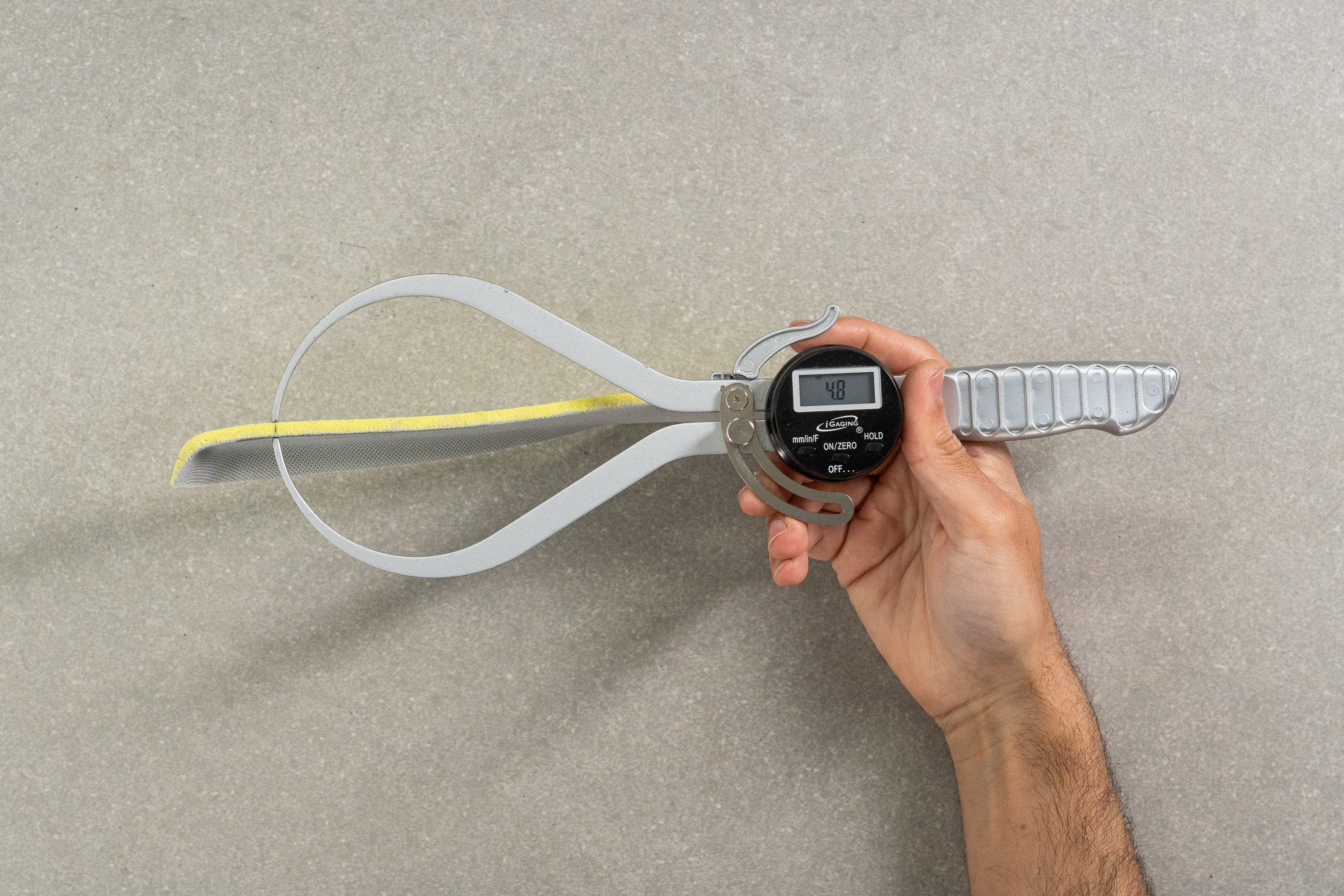
The Hoka Transport is no marshmallow but it's comfy
Despite the plush nature of its foam, the Transport does not feel wobbly or loosey at all!
Bending and twisting it with our hands, we couldn't help but notice how it takes effort to flex the shoe. To assess its forefoot flexibility, we measured the amount of force it takes to bend the Transport to a 30-degree angle. At 18.1N, it required 30% more force indeed!

However, the shoe's stiffness didn't get in the way of smooth transitions. Its platform has a prominent rocker shape which helped our foot roll through each stride effortlessly.
Warning: chilly weather makes it even firmer and stiffer!
Provided that the Hoka Transport is so ready for colder weather, we couldn't help but check how its characteristics change in low temperatures.

This shoe does lose its softness and flexibility to cold and does so quite significantly. After sitting in the freezer for 20 minutes (our version of a cold winter day), the Transport got 43.2% firmer and 70.7% stiffer/less flexible!
It doesn't mean that the shoe is going to feel like a brick but it does require some breaking in to get to the same underfoot feel as in room temperature.
A broad platform contributes to the stability
We have no complaints regarding the shoe's stability. We commend the sole flaring, which is especially noticeable in the forefoot, as it made us feel planted in the Hoka Transport.
We used a pair of callipers to measure the widest part of the shoe's forefoot (112.8 mm) and heel (92.5 mm).

The numbers are significantly wider than what we normally observe in walking shoes - 107.5 mm and 85.2 mm on average.
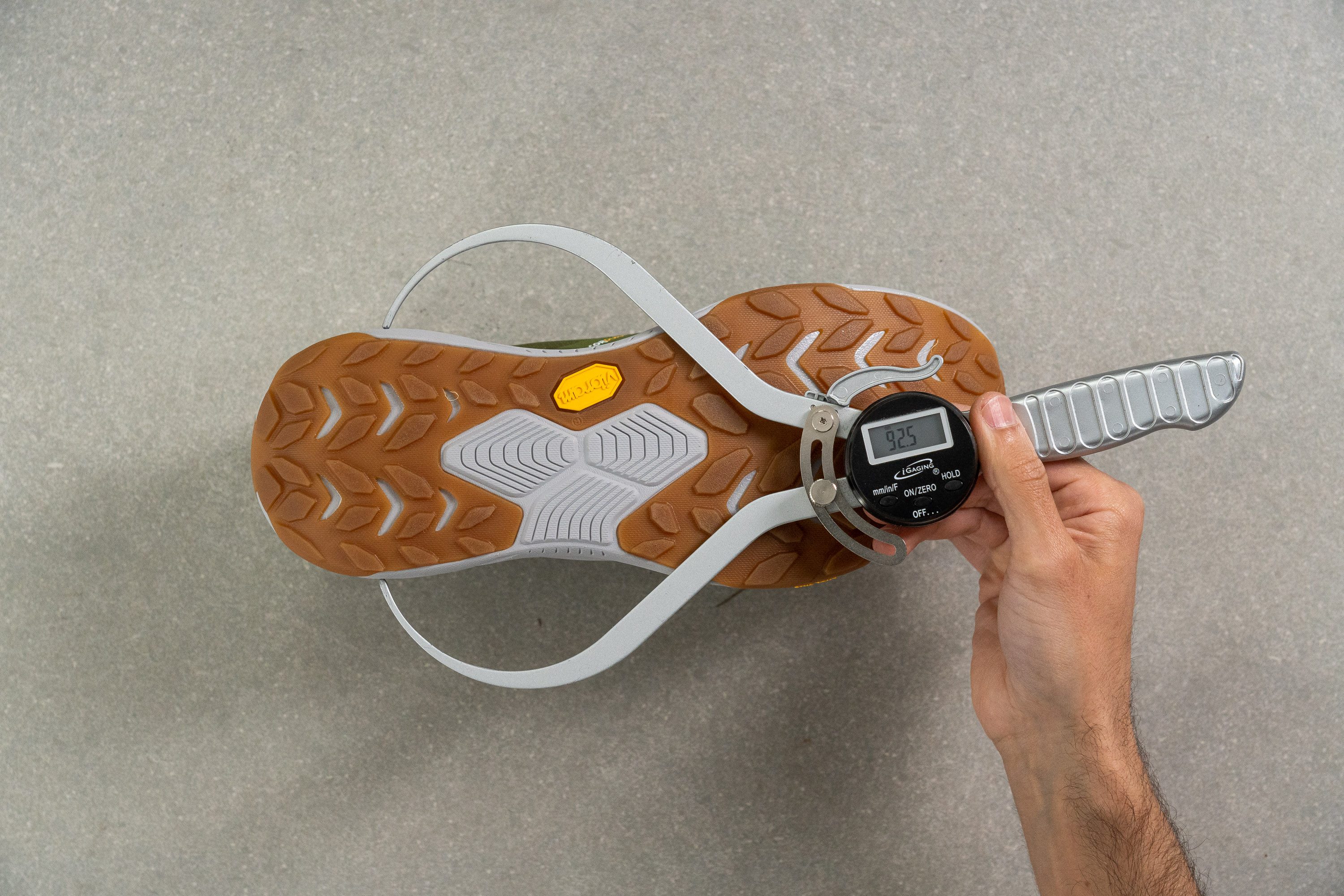
Fits as expected
We appreciate the roomy toe box and true-to-size fit of the Hoka Transport.
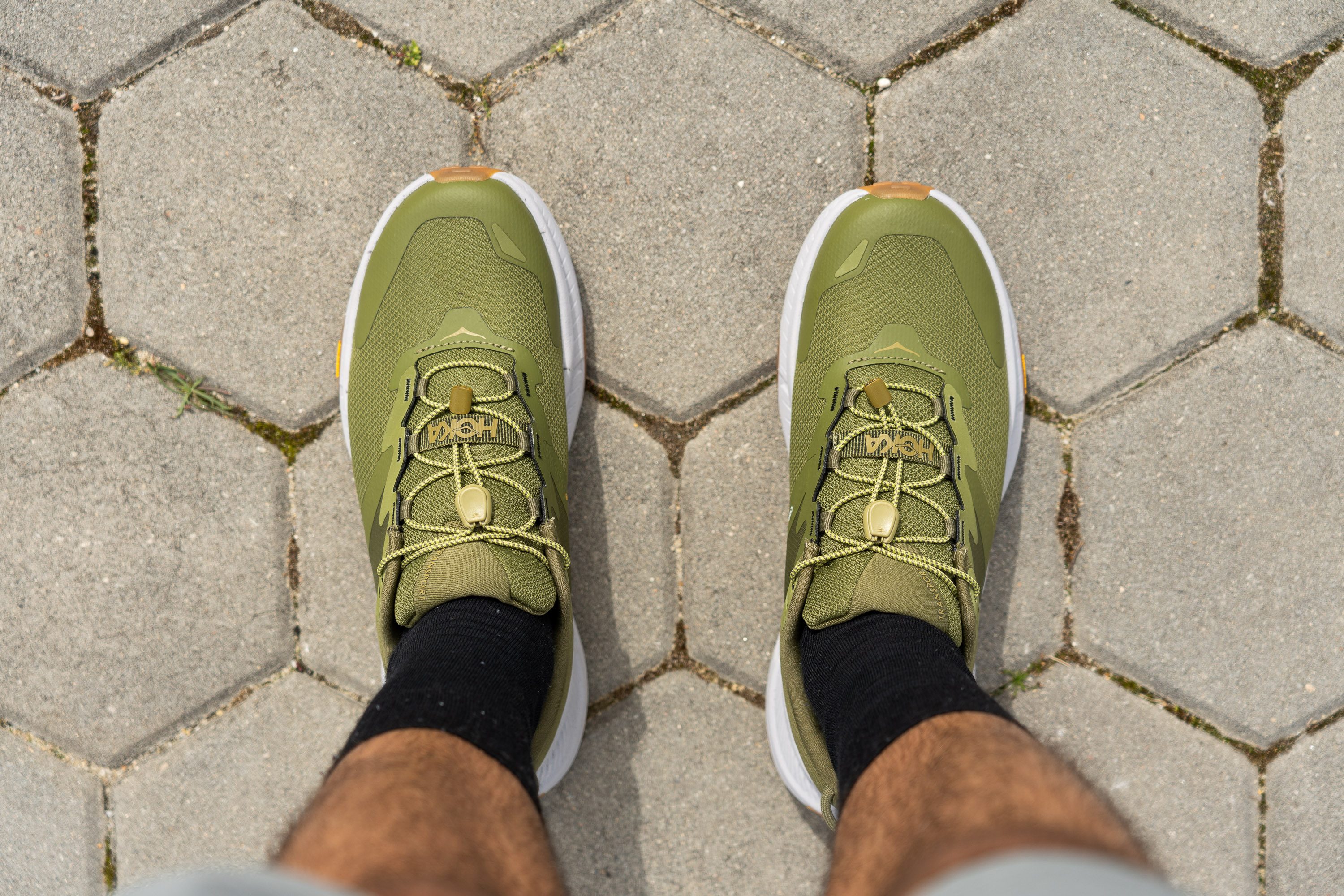
Even though we described it as roomy, we cannot claim it to be a wide shoe. Having measured the widest part of the forefoot (95 mm) as well as the width around the toes (75 mm), we found that the Transport is right at the average of Medium-width toeboxes (95.9 mm and 74.6 mm respectively).
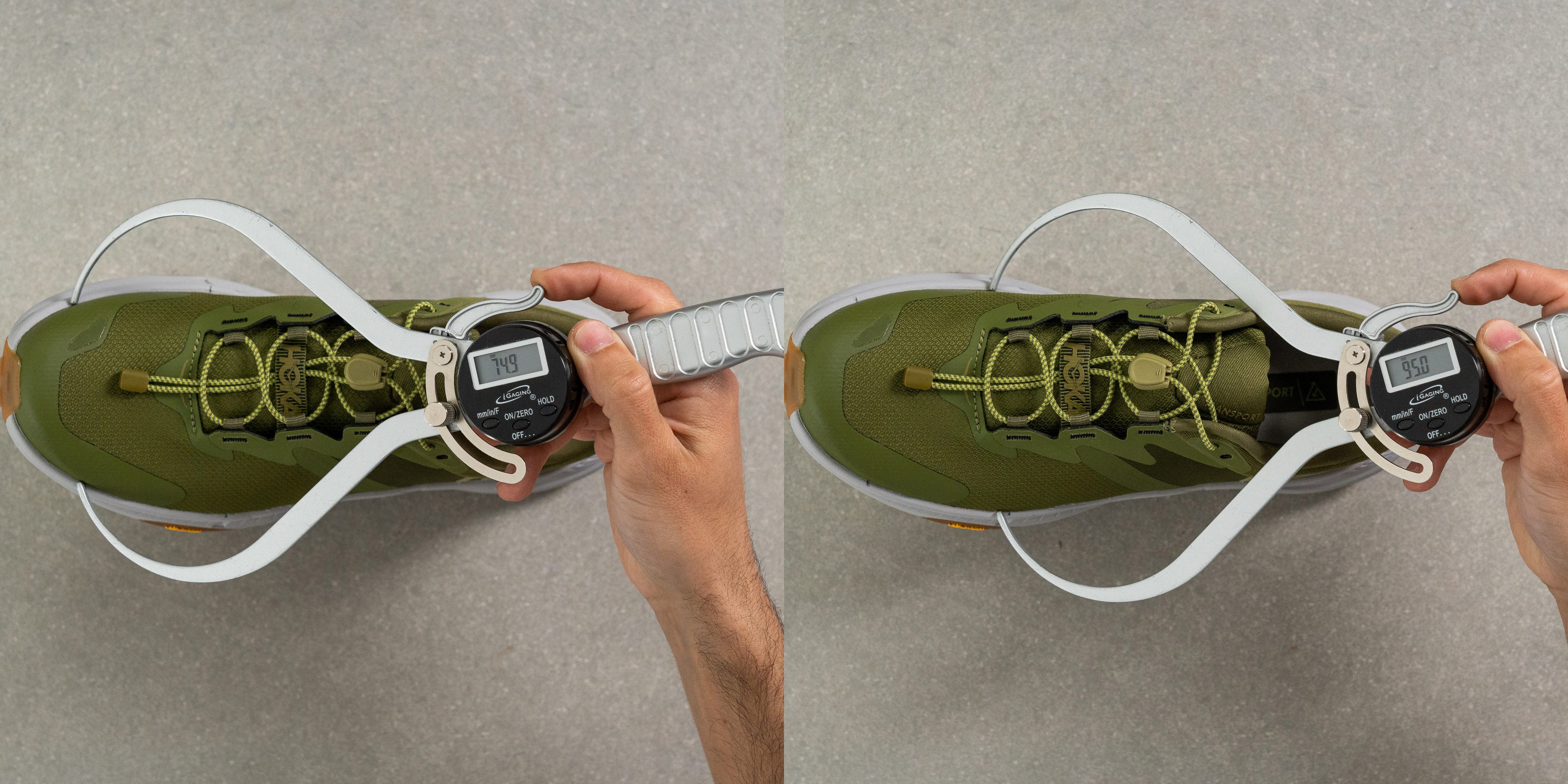
Making the Hoka Transport feel even more secure around the foot are the semi-gusseted tongue and the relatively stiff heel counter.
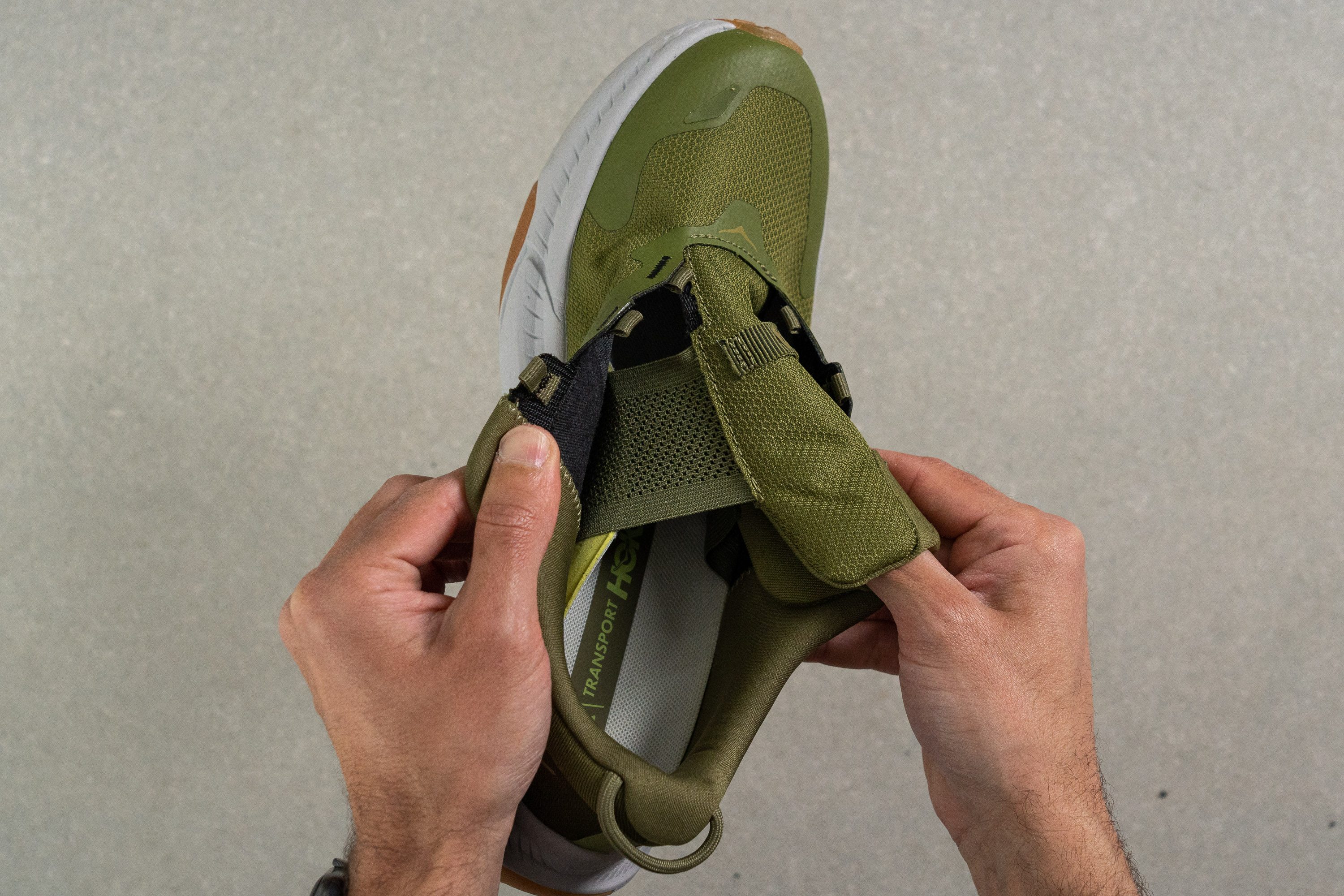
We rated the stiffness of the heel counter as 3 out of 5. This is sturdy enough to prevent the ankle from wobbling sideways.
An outsole that grips and endures
The Vibram rubber used on the Hoka Transport ensures confident strides in many adventures. We trodded through wet and snowy streets and we appreciated how these shoes had exceptional traction.
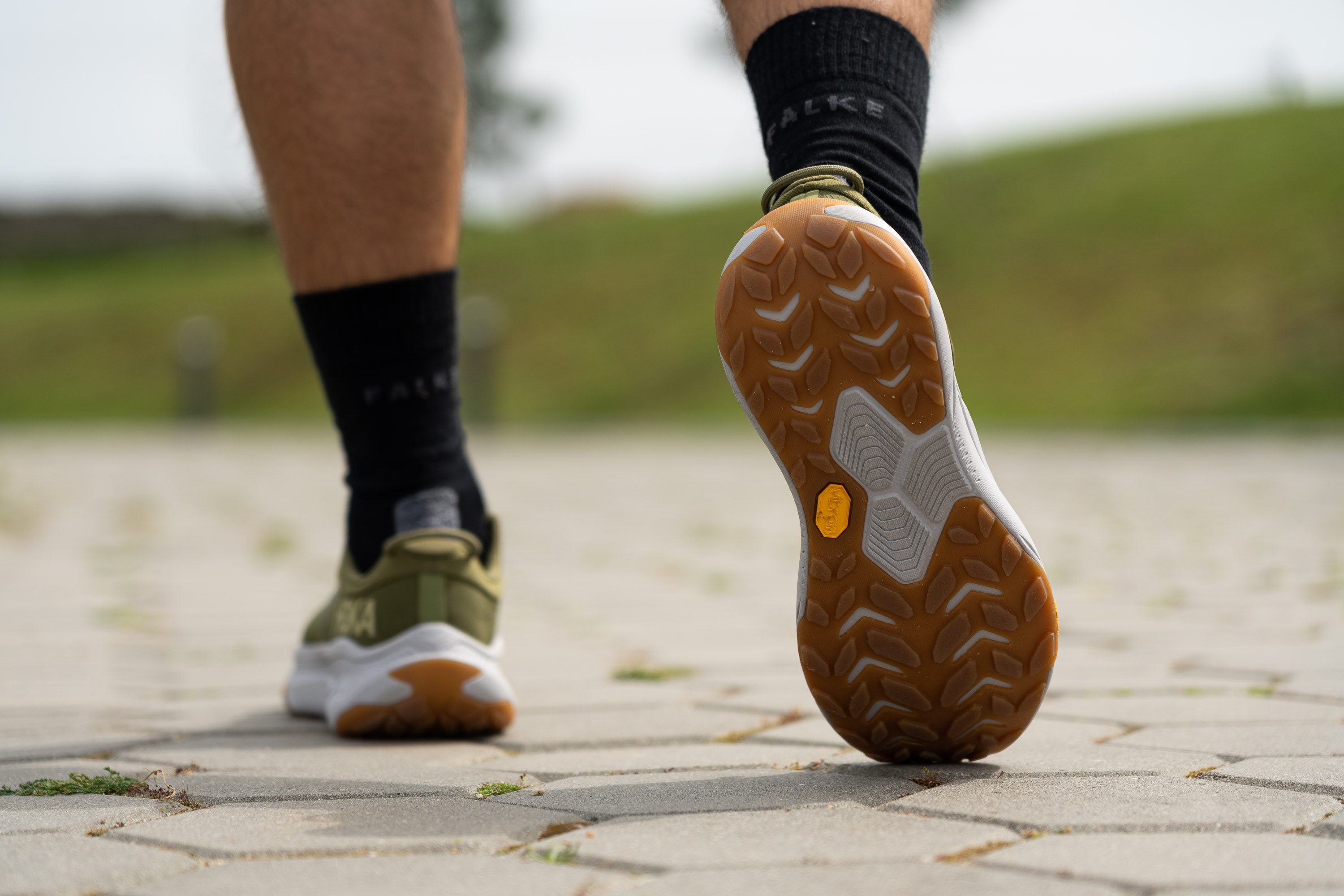
In terms of tread life, we found that putting in 50 miles on our shoes showed no signs of slowing down. We confirmed this by assessing the low level of wear sustained by our shoes after everyday abuse and walking trips.
It is indeed hard to find another walking shoe that could compete in outsole endurance with the Hoka Transport. First of all, at 3.7 mm, its rubber outsole is 2 mm thicker than the average!

Secondly, the hardness of its Vibram rubber stands out from all the other walking shoes we've tested. It is 13% firmer than the average. And why does this matter? Typically, harder rubbers take much longer to wear out than softer ones.

The squeaky soles of the Hoka Transport
We found it very embarrassing whenever we took steps in the Hoka Transport as they noticeably squeak. The good news is, while the soles do squeak, this also subsided after a couple of hours of walking.
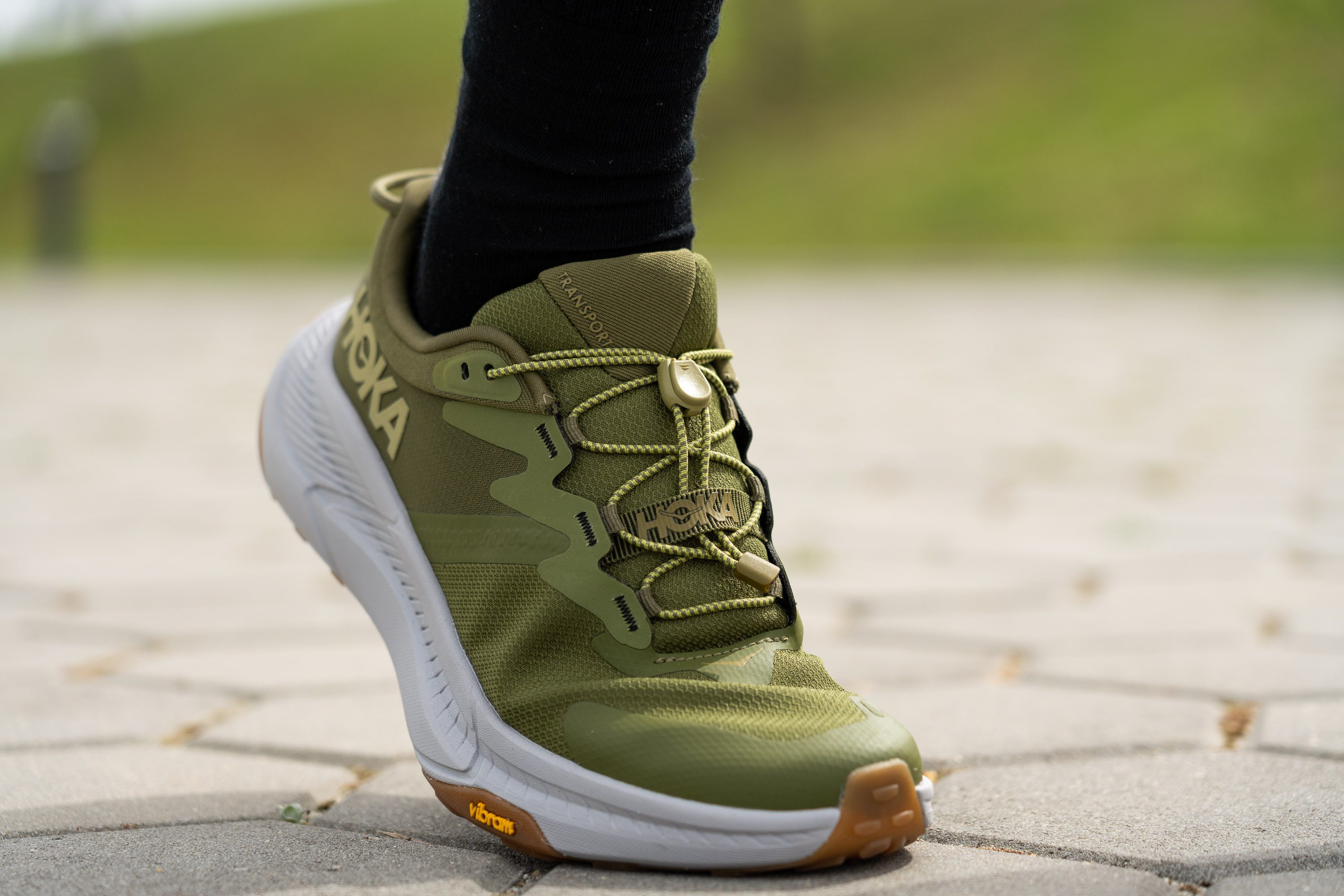
Reflective elements
In addition, we also appreciate the integration of the 360-degree reflective material, which ensures that we stay visible in low light conditions.
